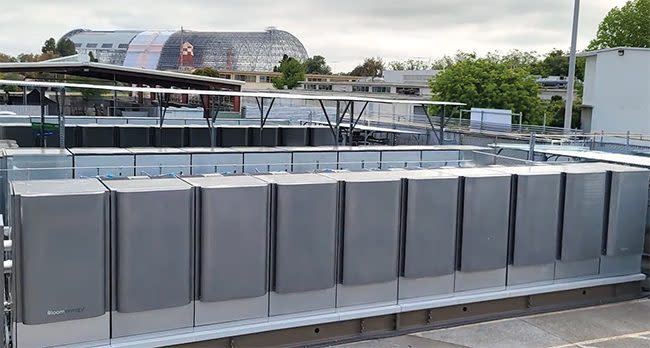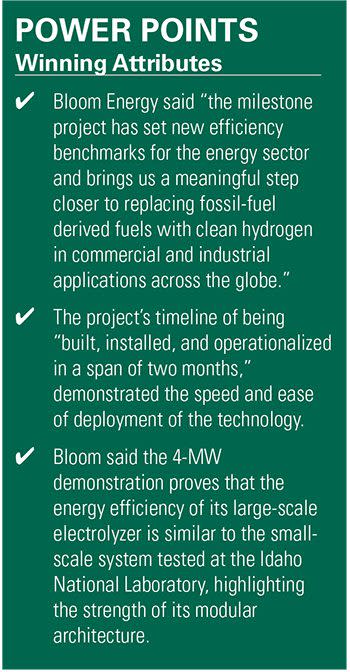Efficiency in Production at Heart of Bloom Technology

Decarbonization of power generation and other industrial sectors relies on hydrogen, and a Bloom Energy demonstration project is supporting the fuel’s production through an advanced electrolyzer system. The use of hydrogen is considered critical to the decarbonization of the energy sector, along with other industries such as transportation, chemical production, and manufacturing. Many companies are looking at ways to produce hydrogen more efficiently, to take advantage of the fuel’s potential to provide flexibility to energy systems. Bloom Energy, a company with roots in the U.S. space program, is considered a pioneer of electrolyzer technology. The San Jose, California-based group today is known for its solid oxide fuel cells that produce on-site electricity, serving commercial and industrial enterprises, including manufacturing facilities and data centers, and supporting combined heat and power systems. Bloom Energy last year began generating hydrogen from what the company calls the “World’s Most Efficient Electrolyzer and Largest Solid Oxide Electrolyzer System,” located at the National Aeronautics and Space Administration’s (NASA’s) Ames Research Center, at the historic Moffett Field research facility in Mountain View, California. Bloom has said the “high-temperature, high-efficiency unit produces 20–25% more hydrogen per megawatt (MW) than commercially demonstrated lower temperature electrolyzers such as proton electrolyte membrane (PEM) or alkaline.” Ravi Prasher, Bloom Energy’s chief technology officer and a leader of the project, told POWER, “The amount of electricity needed by the electrolyzer to make hydrogen will be the most dominant factor in determining hydrogen production cost. For this reason, the efficiency of the electrolyzer, the electricity needed to produce a kilogram of hydrogen, becomes the most critical figure of merit.”
 |
1. Bloom Energy’s 4-MW electrolyzer demonstration project at NASA’s Ames Research Center in California is proving the commercial viability of technology that can produce more hydrogen per megawatt of electricity. Courtesy: Bloom Energy |
Prasher said, “This 4-MW demonstration [Figure 1] at the NASA Ames Research Center proves that the energy efficiency of our large-scale electrolyzer is similar to the small-scale system tested at INL [Idaho National Laboratory] highlighting the strength of our modular architecture. The electrolyzer product is leveraging the Bloom platform know-how of more than 1 GW of solid oxide fuel cells deployed in the field and providing approximately 1 trillion cumulative cell operating hours. “The same technology platform that can convert natural gas and hydrogen to electricity can be used reversibly to convert electricity to hydrogen,” said Prasher. “With Bloom’s high-efficiency, high-temperature solid oxide electrolyzers, we are one step closer to a decarbonized future powered by low-cost clean hydrogen.” The importance of Bloom’s research and this electrolyzer demonstration, which showcases the maturity, efficiency, and commercial readiness of Bloom’s solid oxide technology for large-scale, clean hydrogen production, supports its choice as POWER’s 2024 Hydrogen Award recipient.
A Decarbonized Future Powered by Hydrogen
The 4-MW Bloom Electrolyzer delivers the equivalent of more than 2.4 metric tonnes per day of hydrogen. It was built, installed, and entered operation in a span of just two months. Bloom officials have said the project has “demonstrated the viability of a decarbonized future powered by low-cost clean hydrogen.” Bloom’s electrolyzer technology can trace its history back to work performed as part of NASA’s Mars Space Program more than two decades ago. Dr. KR Sridhar, founder, chairman, and CEO of Bloom Energy, and his team were charged with creating a technology that could sustain life on Mars. They built electrolyzers capable of producing oxygen and fuel from solar power on that planet, and operated the device in the reverse direction as a fuel cell to produce electricity. The group realized the impact of their technology, and founded Bloom Energy in 2001. Interestingly, the demonstration project at Moffett Field is at the same site where Bloom began its operations more than 20 years ago, working in a 7,000-square-foot garage. Bloom in an outline of the project told POWER, “Scalable and abundant clean hydrogen production from electrolysis was previously hindered by a single variable: the cost of electricity. It was therefore imperative for our net-zero future that hydrogen electrolyzers consume as little electricity as possible to support the financial viability of clean hydrogen. “Bloom Energy met this moment with promising results for the clean energy economy of the future. Unlike conventional lower-temperature electrolyzers, such as proton electrolyte membrane or alkaline, Bloom’s high-temperature electrolyzer generates 20-25% more hydrogen per megawatt, demonstrating its superior performance and commercial viability. The demonstration at NASA’s Ames Research Center proved that the world record-setting levels of electrical efficiency achieved by the Bloom electrolyzer’s clean hydrogen production at the Idaho National Laboratory’s Dynamic Energy Testing and Integration Laboratory are also replicable in large-scale, commercial applications. Put simply, the demonstration represents a pivotal moment for the future clean hydrogen economy by cementing the commercial viability of solid oxide technology’s large-scale applications in industrial settings.” Bloom officials told POWER the demonstration at Ames Research Center is distinct from its 100-kW demonstration at INL, though it does build on the findings from that project. The company said, “Specifically, the INL project tested the efficiency of Bloom’s electrolyzer using steam and load simulations that replicate conditions found in nuclear power plant settings. While that effort demonstrated a small-scale installation of Bloom’s electrolyzer can produce clean hydrogen at a record-setting 37.7 kWh per kilogram of hydrogen and with 88.5% lower heating value to DC [direct-current], the effort [at Ames] demonstrated that same level of efficiency was attained by a large-scale installation thanks primarily to the strength of the product’s unique modular architecture.”
Solid Oxide Electrolyzer Technology
Bloom said the success of the demonstration at Ames supports continued deployment of the company’s Solid Oxide Electrolyzer (SOEC) technology, which it is using to develop green hydrogen—hydrogen produced from renewable energy—around the world in addition to production in California, where the electrolyzer is manufactured. Bloom late last year announced a partnership with Southern California Gas, as that utility powers a portion of the California Institute of Technology’s grid with hydrogen. The company told POWER: “Blending existing infrastructure with Bloom’s SOEC technology and fuel cell, we’ve created a microgrid to deliver resilient, affordable, and clean power to one of the Golden State’s leading educational institutions. Specifically, the project takes water from Caltech’s service line and runs it through our electrolyzer using grid energy to create hydrogen for injection into Caltech’s natural gas infrastructure before ultimately being converted to electricity for consumption around campus.” A few months ago, Bloom and SK ecoplant, an engineering and energy solutions provider and subsidiary of South Korean conglomerate SK Group, announced a large-scale, 1.8-MW green hydrogen demonstration using Bloom’s electrolyzer on Jeju Island, South Korea. The demonstration will begin next year, and aims to produce green hydrogen for fuel to support the transportation sector in conjunction with the Korea Southern Power Co. and local governments. Bloom Energy and Shell earlier this year announced a groundbreaking decarbonization study using Bloom’s SOEC technology. The collaboration aims to develop replicable SOEC systems that would produce clean hydrogen, potentially for use at Shell assets around the globe. Bloom told POWER, “This study represents yet another pivotal moment for Bloom as its hydrogen electrolyzer is deployed by hard-to-abate industries in search of solutions that can simultaneously reduce carbon footprints and sustain economic growth due to its world record-setting efficiency.”

‘Positive Outlook’ for Hydrogen
Bloom officials told POWER the company has a “positive outlook” for the hydrogen economy, “in large part due to the milestones met by development of new, exciting, and more efficient technologies,” including its SOEC technology. The group also acknowledged that government intervention and support is likely necessary to support “meaningful advances in this space.” Sridhar noted in May 2023 the Biden administration’s decision to spur development of seven regional clean hydrogen hubs across the U.S., a “$7 billion investment in clean hydrogen [that] reflects the federal government’s confidence that the hydrogen economy can and will deliver a myriad of carbon emissions reduction strategies, perhaps none more important and pressing than power generation.” Bloom Energy is part of four of those hubs. “We were honored that our products and technologies were included in four of the proposals submitted to DOE [the Department of Energy] and we thank [California Gov. Gavin Newsom] for his leadership for securing nearly one-fifth of available funding for projects in California,” a Bloom executive said in October 2023. “Our manufacturing and technology teams in Fremont, California, and Newark, Delaware, are ready to help advance this program and deliver on its promise.” Sridhar said the project at Ames “is a major milestone for reaching net-zero goals” through the use of hydrogen. “Hydrogen will be essential for storing intermittent and curtailed energy and for decarbonizing industrial energy use,” he said. “Commercially viable electrolyzers are the key to unlocking the energy storage puzzle, and solid oxide electrolyzers offer inherently superior technology and economic advantages. Bloom Energy, as the global leader in solid oxide technology, is proud to share this exciting demonstration with the world: our product is ready for prime time.” —Darrell Proctor is a senior associate editor for POWER.

 Yahoo Finance
Yahoo Finance 